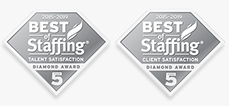Order Taker to Consultant: Q & A Interview with Larry Bonfante
Larry Bonfante is an award-winning CIO, Published Author, Executive Coach, and one of our facilitators in the Technology Leadership Experience (TechLX). He recently conducted an excellent workshop, “Leading in a Technology Organization in the Digital Age”, for our St. Louis cohorts. Following his workshop, we did a one-on-one interview with Bonfante, taking a deeper dive into the topic of what it looks like to have an order taker vs consultant mindset.
Please share your opinion on the key differences from individuals with an order taker vs. consultant mindset.
Bonfante: One mindset is very reactive and the other, proactive. The value you bring to the organization is dramatically different depending on which mindset is brought to the table. In organizations where IT leaders are order takers, they simply wait for the business to come up with a product or need. Subsequently, they view their role simply as fulfilling those needs. I’d argue that is an old mindset from the 1970s or 1980s. In today’s age of digital transformation it’s important to be proactive and go to the business as partners with the ability to say, “here’s what we understand you’re trying to accomplish within the organization, here’s how we think we can add value, and these are the tools (technology and information) we can use to strategically drive outcomes.”
You need an innovative approach –not just innovative technologies– to leverage that technology. To do that you have to understand the business, processes, desired outcomes, and how their going about trying to accomplish them. Secondarily, you need to have a level of credibility and relationships in the business. A trusted advisor gets “the call” as opposed to the order taker. You must have a strong relationship with key stakeholders, requiring relational skills, business acumen skills, and communication skills to function at that level.
This is why programs like TechLX are crucial in adding value to the IT community. A lot of the people we work with in our program have IT leaders develop those competencies so that they can reach out and drive value for the business versus merely fulfilling tactical needs.
How have you seen employees empowered to impact change in their organizations when they adopt a consultant mindset?
Bonfante: Well, those who feel un-empowered are those who wait for something to happen. You know, I joke with my executive coaching clients and say there are only a few kinds of people in the world. People who make things happen, people who watch things happen, and those that wonder what happened. If you’re proactive in making things happen and suggesting solutions, approaches, and ideas to the business, you don’t have to worry about being empowered. If you’re suggesting things proactively that make sense to the business, more likely than not, you’ll create action worthy value. Once those ideas are acted upon you become empowered to now design the disciplined solutions to help drive business outcomes. People who feel un-empowered are just kind of sitting around waiting for somebody to give them a blessing. That’s not effective. Leaders that want to see change have to take the initiative on their own volition and reach out. It has to be proactive. You know, there are offers and demands. People who feel un-empowered wait for demands to be placed on them. People who feel empowered are making offers proactively to others in the organization to do things differently that drive change.
What practical tips can you share with technology leaders in taking small action steps to build their culture in embracing new waves of thinking to lead at the table?
Bonfante: From a cultural perspective, there’s a couple of things I recommend. One is constantly ask, “How can I help you?” Again, don’t wait to be called upon, but make offers of value to the right team members. I also always suggest approaching team members with a a positive spirit on any topic involving change. Keeping it top of mind goes a long way. Be in their face, I don’t mean that in an aggressive way but rather top of mind. The other thing you need to do is build relationships. So you’ve really got to focus on relationship management with your peers. Additionally, if you’re in a senior-level position you need to delegate the day to day stuff down to others
I’m a big believer in empowering people. I always tell my clients that if you’re babysitting your people, you got the wrong people, or they got the wrong manager. So, what you need to do is hire the right people and make sure that they have a clear vision of what success looks like for the organization. Empower them with the tools they need to be successful and get out of their way. Let them do their jobs. Stop babysitting, stop mollycoddling them. Stop. Stop being a human bottleneck where all the decisions have to go through you. When you empower people to make decisions, with appropriate checks and balances, they feel empowered. They feel a sense of ownership and autonomy that its their organization, not yours. And that will free you up best to work with your peers, develop key relationships, and execute strategies.
Have any questions about what we learned here, or want to take your company’s staffing or solutions to the next level? Email us and we can help you figure out what you need to stay up to date!




